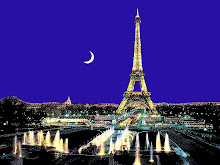I will now and then come back to my Montmartre visit the other day. (By the way,
I have created a second blog, “Peter – photos”, where I for the moment have put the original photos which were part of my patchwork from Montmartre and Place des Abbesses.)
Today a few words about
“Le Moulin de la Galette”:
Originally there were a great number of windmills on Montmartre (maybe thirty), but "Le Moulin de la Galette" is now the only remaining one. Originally it was called “Le Blute Fin” (The Fine Grounded Flour). It belonged to a miller family with four sons, who were all killed during fights between Russians and local defenders which took place on Montmartre in 1814 (Napoleon…). The eldest brother was killed the last, at the family windmill, but had first managed to give a fatal rifle blow killing the Russian commander. He was cut into pieces by the Russians and they used the pieces to “decorate” the mill wings. The four brothers were buried in the small local cemetery and their mother put a red painted miniature windmill on top of the grave. You can still visit this small cemetery, but only once a year (November 1). The grave is still there, but the miniature windmill has lost its colour. Anyhow, this red painted miniature mill became famous and later gave the name to the worldwide known “Moulin Rouge” (where no flour has ever been grounded).
The son of the eldest brother participated in the fight where his father was killed. He was seriously wounded and decided to change activity. He transformed the mill to a “guinguette” (small place for eating and dancing) and changed the name to “Le Moulin de la Galette” (Galette = thin pancake).
The “guinguette” was much visited and painted by some famous artists, like
Corot,
Renoir,
van Gogh,
Toulouse-Lautrec,
van Dongen,
Picasso,
Utrillo...

 There is today a restaurant at Montmartre with a small windmill on top of it. The restaurant is called “Le Moulin de la Galette”, and many would think that this is the real one.
There is today a restaurant at Montmartre with a small windmill on top of it. The restaurant is called “Le Moulin de la Galette”, and many would think that this is the real one.
 However, the real windmill with this name is slightly behind this restaurant and can hardly be seen; the close access to the mill is today not possible, but I have some distant photos, where you can imagine it behind the leaves.
However, the real windmill with this name is slightly behind this restaurant and can hardly be seen; the close access to the mill is today not possible, but I have some distant photos, where you can imagine it behind the leaves.
Correction: This info is slightly false. Please see a hopefully improved version on my post of March 25, 2009, on my new blog, Peter's Paris. (Click above undr "HERE".)
I made a comparison between what Utrillo painted and what I could see. Not too much of a difference, except that the trees have grown. I should try again in December, when the leaves are not there any more.



































































